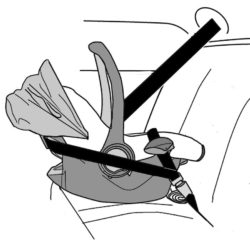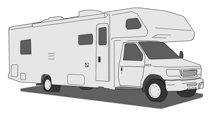The following car seat brands have been out of business in the U.S. for many years and their CRs models are expired and should no longer be in use. Therefore, we’ve removed these entries from the 2015 and newer LATCH Manuals. For anyone interested in this information, however, we’ve posted it here:
News
What CPSTs, Caregivers Should Know About European Belt Routing
European belt routing for rear-facing CRs is not new here in the U.S. For many years there have been at least a few RF-only models with this installation option. However, with growing global influence in the CR marketplace, models with this option have been on the rise in recent years. This article takes a closer look at this installation method.
Read More from “What CPSTs, Caregivers Should Know About European Belt Routing”
IIHS Lists Recommended Used Vehicles
 As covered in the related articles on this page, teens tend to drive in older vehicles with fewer safety features than do other drivers. This contributes significantly to their high crash and injury rate. To help parents reduce these risks, the IIHS rated 95 used vehicle models as either “best” or “good,” indicating specific model years for each.
As covered in the related articles on this page, teens tend to drive in older vehicles with fewer safety features than do other drivers. This contributes significantly to their high crash and injury rate. To help parents reduce these risks, the IIHS rated 95 used vehicle models as either “best” or “good,” indicating specific model years for each.
Children in Aircraft
“We are flying to my mother’s, and I see that I can carry my 1-year-old on my lap, which will save us a lot of money . . .”
The temptation to save money by having a child under age 2 ride on a parent’s lap presents a common dilemma for families. Adding to the confusion is the fact that airlines and the FAA seem to condone the unsafe behavior and that most people figure a plane crash cannot be survived, with or without a CR.
The truth is that all passengers, including young children, are safer when buckled up on an airplane. Although the FAA concluded in August 2005 that it would not require families to purchase a seat for children under age 2, the rationale was data (since convincingly refuted) showing that families would prefer to drive (generally more risky) if they otherwise would have to purchase a plane ticket for the child.
Children in RVs
“We are planning a big cross-country tour this summer and figure it would make sense to rent an RV for this adventure . . .”
Often, even parents who normally are careful to use a CR for their children for every ride imagine that the interior of a recreational vehicle (RV, or motor home) is somehow a magical zone where the laws of physics do not apply. Caregivers need to know that an RV may not be safe for children.
Children still need to be buckled up appropriately any time they are riding in a vehicle, and this can be a real challenge in an RV. RVs come in a range of style classes (A, B, C, C+, etc.) and, although these do vary in appropriateness for families, none is ideal.
Children in Taxis
“We are visiting a large city, so we will be using taxis rather than a rental car . . .”
A 2006 study using 2004 data found that, in New York City alone, there were 25 taxi/livery crashes every day that caused injury. That study also found that when taxis were involved in a crash, the taxi passengers were nearly 2.5 times more likely to be seriously injured or killed than the passengers in the other vehicle in the crash.
So, best practice in taxis (and, in some states, the law) is to use a CR. Dr. Alisa Baer, pediatrician and cofounder of The Car Seat Lady, posts excellent advice on this subject at www.thecarseatlady.com.
UberFamily Adds CR Option
Visiting NYC? Check out this safety option for kids
In May, options for traveling safely with kids in New York City improved dramatically. Uber, a tech company that creates mobile apps to connect passengers with drivers of for-hire vehicles, added a new option, uberFAMILY. For an upcharge of $10 per ride, customers selecting uberFAMILY from the Uber app will be sent a car that has a forward-facing CR with a five-point harness preinstalled by a trained driver. The service is offered for children over age 1 (and at least 22 pounds/31 inches) and up to 48 pounds or 52 inches. (Children smaller and larger than that are urged to use the appropriate RF-only CR or booster, respectively.)
Read More from “UberFamily Adds CR Option”
One More Note on LATCH Weight Limits: What Do We Tell the Folks?
I was recently asked whether our SRN Fact Sheets were updated to reflect the recent changes to FMVSS 213. While I assured the customer that we had reviewed all sheets and made any edits needed, I also noted that the changes were minor. Our fact sheets are meant to provide caregivers with easy-to-read information about best practice, so technical details about subjects like regulations are not appropriate and would in fact detract from the key safety messages.
However, this hints at broader questions that others might share: What do caregivers need to know about the recent update to LATCH weight limits and CR labeling? And, exactly how should our parent information be changed so it’s current?
Read More from “One More Note on LATCH Weight Limits: What Do We Tell the Folks?”
Good News for Hospitals: Guidelines for CPS-Related Discharge Policies Available
Hospitals can now access free, expert guidance for developing discharge policies related to CPS. In March, the Hospital CPS Discharge Policy Planning Group, an expert working group convened by NHTSA, released a report titled “Hospital Discharge Recommendations for Safe Transportation of Children.” The purpose of this project, which came about after years of collaboration by multiple organizations and contributors, is to encourage hospitals to address CPS in their discharge policies. It defines “child patient” as any from birth to age 19, including but not limited to those with special healthcare needs.
Read More from “Good News for Hospitals: Guidelines for CPS-Related Discharge Policies Available”
Weight Limit Labels a Step Forward for LATCH
This issue of SRN celebrates the amendments to FMVSS 213 that went into full effect on February 27, 2014, expanding the standard’s scope to include CRs for children up to 80 pounds (formerly 65 pounds). Although the purpose of this expansion, when first directed by Congress over 10 years ago, was to bring most boosters under FMVSS 213, the effect is to also ensure that today’s wide array of CRs with very high-weight harnesses will be tested according to the standard’s requirements.
Read More from “Weight Limit Labels a Step Forward for LATCH”





